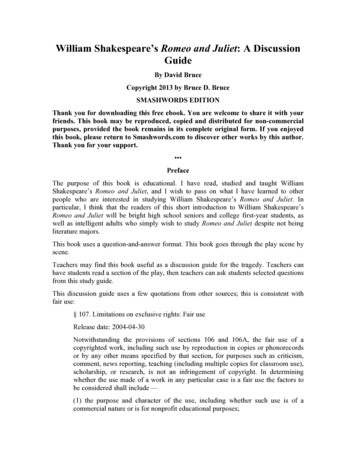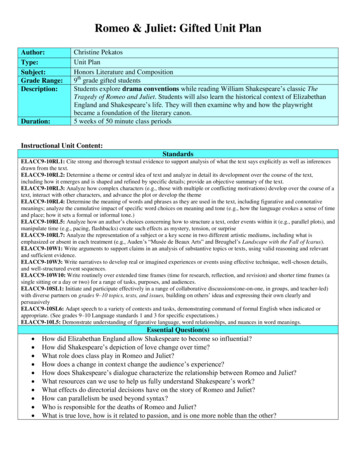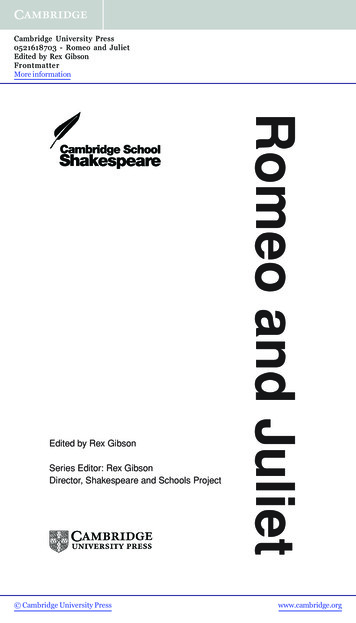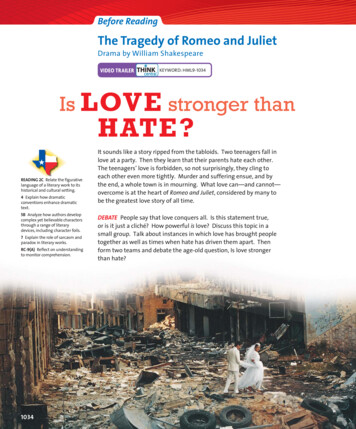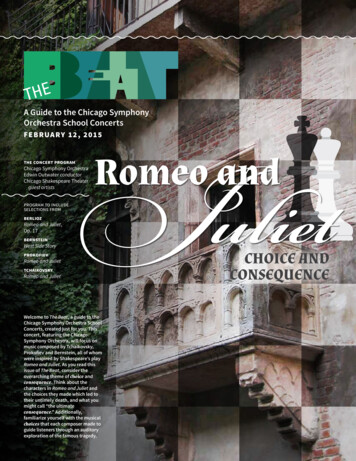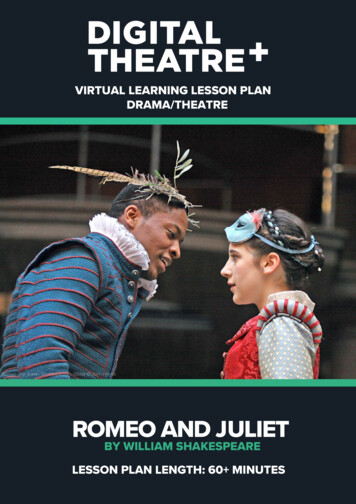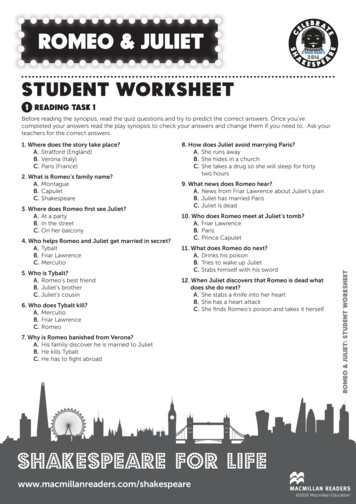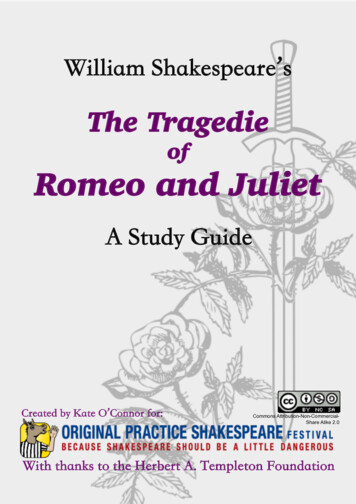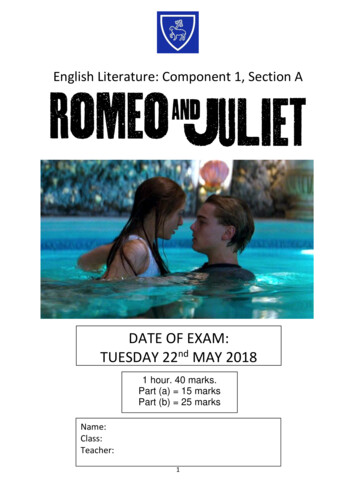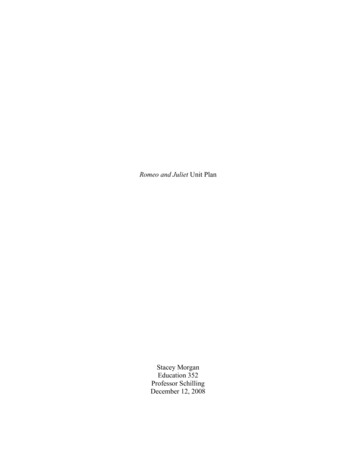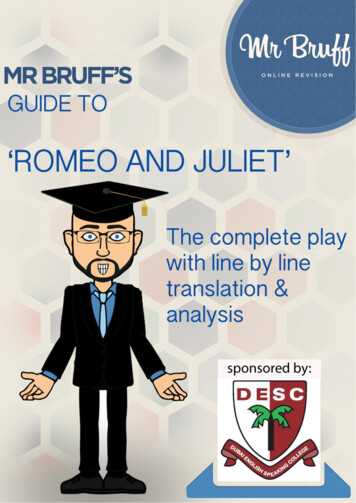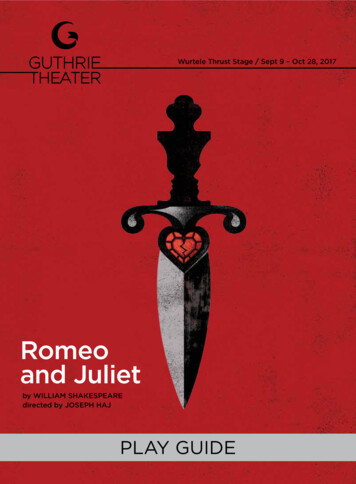
Transcription
Wurtele Thrust Stage / Sept 9 – Oct 28, 2017Romeoand Julietby WILLIAM SHAKESPEAREdirected by JOSEPH HAJPLAY GUIDE
InsideTHE PLAYSynopsis, Setting and Characters 3Production History for Romeo and Juliet 4, 5Responses to Romeo and Juliet 6THE PLAYWRIGHTAbout the Playwright 7A Legacy that continues to inspire 8Shakespeare’s Plays 9BUILDING THE PRODUCTIONFrom the Director: Joseph Haj 10From the Sound Designer: Vincent Olivieri 11From the Scenic Designer: Anna Louizos 12From the Lighting Designer: Josh Epstein 13From the Composer: Victor Zupanc 14ADDITIONAL INFORMATIONActivities Guide 15, 16For Further Reading and Understanding 17Play guides are made possible byGuthrie Theater Play GuideCopyright 2017DRAMATURG Carla SteenGRAPHIC DESIGNER Akemi GravesCONTRIBUTORS Jason Brown and Carla SteenGuthrie Theater, 818 South 2nd Street, Minneapolis, MN 55415ADMINISTRATION 612.225.6000BOX OFFICE 612.377.2224 or 1.877.44.STAGE TOLL-FREEguthrietheater.org Joseph Haj, artistic directorThe Guthrie Theater, founded in 1963, is an American center for theater performance,production, education and professional training. By presenting both classical literature andnew work from diverse cultures, the Guthrie illuminates the common humanity connectingMinnesota to the peoples of the world.2 \ GUTHRIE THEATERAll rights reserved. With the exception of classroom use byteachers and individual personal use, no part of this Play Guidemay be reproduced in any form or by any means, electronicor mechanical, including photocopying or recording, or by aninformation storage and retrieval system, without permission inwriting from the publishers. Some materials published hereinare written especially for our Guide. Others are reprinted bypermission of their publishers.The Guthrie Theater receives support from the NationalEndowment for the Arts. This activity is made possible in partby the Minnesota State Arts Board, through an appropriationby the Minnesota State Legislature. The Minnesota State ArtsBoard received additional funds to support this activity fromthe National Endowment for the Arts.
THE PLAYSettingThe Guthrie production sets theplay in contemporary Verona,Italy, with a one scene inMantua, about 25 miles away.CharactersKate Eastman and Ryan-James Hatanaka (Photo by Jenny Graham)SynopsisRomeo and Juliet is set in Verona, Italy, where the rival houses of Capuletand Montague have a longstanding feud that erupts with a new fight inthe streets. Following this latest brawl, the Prince decrees a penalty ofdeath for whoever next breaks the peace. Romeo, a Montague pining inunrequited love for Rosaline, wasn’t part of the brawl but jumps at thechance to crash a party at the Capulet house when he learns Rosalineis to be there. He, his friend Mercutio and cousin Benvolio arrive at theCapulets in masks, but Tybalt, a hot-headed Capulet, recognizes Romeo’svoice and vows revenge for Romeo arriving uninvited. Romeo seesJuliet, the daughter of Capulet, and they fall in love immediately. Laterthat night, he climbs the orchard wall to talk with Juliet from beneaththe balcony outside her bedchamber. With the help of Juliet’s Nurseand Romeo’s friend and confessor Friar Lawrence, and hoping to mendthe families’ division, the two secretly marry the following day, but theirhappiness does not last long. Tybalt challenges Romeo to a duel, andwhen Romeo refuses to fight his new kinsman, Mercutio faces Tybalt andis killed. In anger and revenge Romeo kills Tybalt, for which he is banishedfrom the city. He spends a single night with his new bride and leaves forMantua the next morning. Apparently divided forever, the two youngpeople take desperate action to overcome the forces that keep themapart, but mistimed communication leads to an unfortunate and deadlyend.Prince of VeronaParis, his kinsman and a suitorto JulietParis’ pageLord CapuletLady CapuletJuliet Capulet, their daughterNurse, to JulietTybalt, nephew to LadyCapuletPotpan, servant to theCapuletsGregory, servant to theCapuletsLady MontagueRomeo Montague, her sonBenvolio, cousin to RomeoMercutio, friend to Romeo andkinsman to the princeBalthasar, servant to RomeoFriar Lawrence, of theFranciscan orderFriar John, of the FranciscanorderApothecary, in MantuaGUTHRIE THEATER \ 3
THE PLAYProduction Historyfor Romeo and JulietCompiled by Gina Musto, Literary InternRomeo and Juliet was firstperformed between 1595 and 1598at the Curtain, the theater whereShakespeare’s company performedbefore the Globe opened in 1599.Richard Burbage created the roleof Romeo and Robert Goffe, whoplayed most of Shakespeare’sleading ladies, played Juliet. Giventhe size of the company andnumber of roles, there was likelya lot of doubling. The productionwould have used contemporaryclothing of the time, as was thenorm in Shakespeare’s productions.The first performance of which wehave an official record occurred in1660 by the Duke’s Company anda revival took place on March 1,1662. Famed diary-keeper SamuelPepys was unimpressed with thisproduction, writing “it is the playof itself the worst that I ever heardin my life, and the worst actedthat ever I saw these people do.”(Though it’s possible Pepys saw anadaptation of the play by JamesHoward which featured a Mrs.Saunderson as Juliet, probably thefirst woman to play the role.)In October 1679 the Duke’sCompany produced ThomasOtway’s Caius Marius, anadaptation of Romeo and Juliet,giving the play a Roman republicansetting with Restoration politicalovertones. Though critics did nothave kind things to say about theproduction, it held the stage forover 60 years.In 1744, Shakespeare’s play, withmany intrusions from Otway’sversion, was revived and adaptedby Theophilus Cibber at the LittleHaymarket.David Garrick undertook a revivalat Drury Lane in 1748 and preparedan acting version which, with minorchanges, held the stage for the restof the century. It received morethan 450 performances by 1800and between 1750 and 1800 wasthe most popular of Shakespeare’splays. Slightly modified by J.P.Kemble around 1803, Garrick’sversion continued to be performeduntil the middle of the 19th century.In 1845, the play was performedusing Shakespeare’s text (albeitheavily cut) at the HaymarketTheatre. Susan Cushman playedJuliet opposite her sister, Charlotte,as Romeo.While the Garrick-Kemble scriptcontinued to be used in minor/amateur productions, major revivals(Edwin Booth’s in 1868, HenryIrving’s in 1882, Mary Anderson’s in4 \ GUTHRIE THEATERRyan-James Hatanaka, Kelsey Didion, Lamar Jeffersonand Jason Rojas (Photo by Jenny Graham)
Shá Cage, Kate Eastman and Candace Barrett Birk (Photo by Jenny Graham)1884 and Maude Adams’ in 1899)did not use the script, though MaryAnderson’s did retain a funeralprocession Garrick had written in.Toward the end of the 19th century,changes in the presentationof the play were implemented.Previously, productions weredone in contemporary dress (suchas Romeo appearing in a waistcoat, knee breeches and a threecornered cocked hat in the mid18th century), but from the latterpart of the 19th century, an interestin setting and costuming the playfor 12th century Verona took hold,and a need for “historical accuracy”could be found in productionsinto the first decade of the 20thcentury, particularly under HenryIrving and Herbert Beerbohm Tree.William Poel, who wished to returnto Elizabethan costuming in hisproductions, and Harley GranvilleBarker, who used some of Poel’sideas and restored Shakespeare’stexts as far as possible, were theleading innovators of what hasbecome known as the modernapproach to staging Shakespeare.Modifications to the text continued,including a 1919 production withEllen Terry as the Nurse in which allof Act 3, Scene 2 (Juliet learningabout Romeo’s banishment) wascut and the play ended with Juliet’ssuicide.Peter Brook’s 1947 Stratfordproduction omitted all of Act4, Scene 1 (Juliet’s visit to FriarLawrence) apparently to avoida scene change and ended withJuliet’s death and a short commentfrom the Chorus, borrowed fromthe Prince’s lines.In 1960, Franco Zeffirelli directeda production of Romeo and Julietat the Old Vic which, throughhis later film version in 1968,has greatly influenced the waypeople generally perceive howthe play should be staged andacted. Zeffirelli cut the text toaccommodate a more cinematicfocus on large action scenes andspectacle.Interest in making the young loversmore socially recognizable hasbecome a common intent, froma production with Juliet playedin a modern American secondaryschool uniform to Michael Boyd’sRSC production in 2000 whereMercutio was also a suitor forRomeo’s affection, haunting therelationship even in death.Baz Luhrmann’s 1996 film WilliamShakespeare’s Romeo Julietfollows closely to the plot andlanguage of the original play whilestaging the story in a modern,seaside dystopia of VeronaBeach. The setting borrows fromother Shakespeare plays to nameestablishments “Merchant ofVerona” Loan Company and a“Mistress Quickly” massage parlor.With densely packed culturallocales, young Claire Danes andLeonardo DiCaprio in the title roles,and a racially and ethnically diversecast in a setting that could be inFlorida or Southern California, thisfilm is visually rich, complex andindicative of America and postmodern culture.GUTHRIE THEATER \ 5
THE PLAYResponses toRomeo and JulietShakespeare showed the best ofhis skill in his Mercutio, and hesaid himself, that he was forcedto kill him in the third act, toprevent being killed by him. But,for my part, I cannot find he was sodangerous a person; I see nothingin him but what was so exceedinglyharmless, that he might have livedto the end of the Play and died in hisbed without any offense to any man.John Dryden, “Defence of the Epilogue,” 1672Romeo and Juliet is lyric tragedy,and this must be the key to itsinterpreting. It seems to have beenShakespeare’s first unquestionablesuccess, proof positive of hisunique quality. If marred by oneor two clumsy turns, its stagecraftis simple and sufficient; and thecommand of dramatic effect ismasterly already. It is immaturework still, but it is not crude. Thewriting shows us a Shakespeareskilled in devices that he is soonto reject or adapt to new purpose.This, which to the critic is one ofthe most interesting things aboutthe play, is a stumbling block toits acting. But the passion andpoignant beauty of it all, when wesurrender ourselves to them, makesuch reservations of small enoughaccount.Harley Granville-Barker, Prefaces toShakespeare, Princeton University Press,1947What I have attempted is to breakaway from the popular conceptionof Romeo and Juliet as a prettypretty, sentimental love story, andto get back to the violence, the6 \ GUTHRIE THEATERpassion, and the excitement ofthe stinking crowds, the feuds, theintrigues. To recapture the poetryand the beauty that arise from theVeronese sewer, and to which thestory of the two lovers is merelyincidental.We knew before we started thatto attempt anything so radical as acomplete break with tradition in aplay so well loved an popular wasbound to arouse fierce antagonism.We were right – it has. And wewelcome the criticism – it is healthyand it is helpful – but it is onlyby the judgment of the peoplecoming to Stratford-on-Avonpurely to enjoy the performance,and with no preconceptions aboutShakespearean production, that weshall be able to tell to what extendour attempt to find a new pathfor the 1940s is justified and is theright one.Peter Brook, “Shakespeare Isn’t a Bore,” inThe Shifting Point, Harper & Row, 1987Franco Zeffirelli’s “Romeo andJuliet” is a lovely, sensitive, friendlypopularization of the play – thelovers, Leonard Whiting and OliviaHussey, as young and full of lifeas they ought to be. But for thepoetry, and the fine archaic dignityof Romeo and Juliet, the story couldbe taking place next door. It is thesweetest, the most contemporaryromance on film this year.Renata Adler, “The Screen: Zeffirelli’s‘Romeo and Juliet’ Opens,” The New YorkTimes, October 9, 1968Shakespeare wrote A MidsummerNight’s Dream in the same yearsthat he wrote Romeo and Juliet,and the two plays have a great dealin common. In a way we could saythat A Midsummer Night’s Dream isRomeo and Juliet turned inside out,Romeo and Juliet transformed intoa comedy. In both plays there arestrong central figures of authoritywho attempt to order the world– the Prince in Romeo and Juliet;Theseus, Duke of Athens, in AMidsummer Night’s Dream; In thetwo plays there are fathers whowant to choose their daughters’husbands – old Capulet wantsJuliet to marry Paris, Egeus wantsHermia to marry Demetrius – andin both cases the women refuse,choosing instead other lovers(Romeo, Lysander) and planningto run away with them. In bothplays the disobedient or rebelliousdaughter is threatened with theife a nun (Friar Laurence says hewill “dispose” of Juliet among “asisterhood of holy nuns”; Hermiais asked to imagine wearing “thelivery of a nun, / Chanting fainthymns to the cold fruitless moon”).Both plays strongly emphasize thedifference between night, whichtransforms and changes, andday, which is rigid, inflexible, andassociated with law.Marjorie Garber, Shakespeare After All,Anchor Books, 2004
THE PLAYWRIGHTAbout the Playwrightwould have three children,Susanna in 1583 and twinsHamnet and Judith in 1585.William ShakespeareWilliam Shakespeare wasborn in 1564 to John andMary Arden Shakespeare andraised in Stratford-upon-Avon,Warwickshire, in England’sWest Country. Much of theinformation about him comesfrom official documents suchas wills, legal documents andcourt records. There are alsocontemporary references tohim and his writing. In all,while much of the biographicalinformation is sketchy andincomplete, for a personof his class, as the son of atown alderman, quite a lot ofinformation is available.Young Shakespeare would haveattended the Stratford grammarschool, where he would havelearned to read and write notonly English, but also a lot ofLatin and some Greek. In 1582,at age 18, Shakespeare marriedAnne Hathaway, and the coupleAfter an eight-year gap whereShakespeare’s activity is notknown, he appeared in Londonby 1592 and quickly beganto make a name for himselfas a prolific playwright. Hestayed in London for about 20years, becoming increasinglysuccessful in his work as anactor, writer and shareholder inhis acting company. Retirementtook him back to Stratfordto lead the life of a countrygentleman. His son Hamnet diedat age 11, but both daughterswere married, Susanna to Dr.John Hall, and Judith to ThomasQuiney.Shakespeare died in Stratfordon what is thought to be hisbirthday, April 23, in 1616. Heis buried in the parish church,where his grave can be seento this day. His known bodyof work includes at least 37plays, two long poems and 154sonnets.GUTHRIE THEATER \ 7
THE PLAYWRIGHTA Legacy that continues to inspireThe Poetry of Shakespeare wasInspiration indeed: he is not somuch an Imitator as an Instrumentof Nature; and ’tis not so just to saythat he speaks from her, as that shespeaks through him.His characters are intimately boundup with the audience. That is whyhis plays are the greatest examplethere is of a people’s theater; inthis theater the public found andstill finds its own problems and reexperiences them.Alexander Pope, Preface to The Works ofShakespeare, 1725Jean-Paul Sartre, On Theater, 1959We do not understand Shakespearefrom a single reading, and certainlynot from a single play. There is arelation between the various playsof Shakespeare, taken in order; andit is work of years to venture evenone individual interpretation of thepattern in Shakespeare’s carpet.[A]lthough each play is a separateand individual work of art, they allgenerally illuminate one another,and taken together they form animpressive achievement in whicheach individual play acquiresmore weight and dignity whenplaced against the backgroundof the whole corpus. Each playis more or less a landmark in theroad along which Shakespeare theartist traveled, or, to change themetaphor, each play is a variationon a number of themes that recurin the poet’s work.T. S. Eliot, Dante, Faber & Faber, 1929Shakespeare’s mind is the typeof the androgynous, of the manwoman mind. It is fatal foranyone who writes to think of theirsex. It is fatal to be a man or awoman pure and simple; one mustbe woman-manly or man-womanly.M.M. Badawn, Background to Shakespeare,Macmillian India Limited, 1981Virginia Woolf, A Room of One’s Own, 1929If one takes those thirty-sevenplays with all the radar lines ofthe different viewpoints of thedifferent characters, one comes outwith a field of incredible densityand complexity; and eventuallyone goes a step further, and onefinds that what happened, whatpassed through this man calledShakespeare and came intoexistence on sheets of paper, issomething quite different fromany other author’s work. It’s notShakespeare’s view of the world,it’s something which actuallyresembles reality. A sign of thisis that any single word, line,Stan Demidoff and Kelsey Didion(Photo by Jenny Graham)character or event has not only alarge number of interpretations,but an unlimited number. Whichis the characteristic of reality. An artist may try to capture andreflect your action, but actually heinterprets it – so that a naturalisticpainting, a Picasso painting, aphotograph, are all interpretations.But in itself, the action of oneman touching his head is opento unlimited understanding andinterpretation. In reality, that is.What Shakespeare wrote carriesthat characteristic. What he wroteis not interpretations: it is the thingitself.Peter Brook, “What is Shakespeare?” (1947),in The Shifting Point, Harper & Row, 1987Every age creates itsown Shakespeare. Like a portraitwhose eyes seem tofollow you around theroom, engaging yourglance from everyangle, [his] playsand their charactersseem always to be“modern,” always tobe “us.”Marjorie Garber, Shakespeare AfterAll, Anchor Books, 2004
THE PLAYWRIGHTShakespeare’s PlaysZlato Rizziolli, Wayne T. Carr and Sam Wick in Pericles (Jenny Graham); Nathaniel Fuller in King Lear (T Charles Erickson); Kate Eastman in Romeo and Juliet (Jenny Graham)EARLY PERIODRomeo and Juliet is a relativelyearly work in Shakespeare’scanon, usually dated between1591 and 1596. Speculationvaries about when it may havefirst been performed, thoughbetween 1595 and 1598 seemsprobable. The first time the playwas published was in 1597, whenthe first quarto appeared.The primary source for the playwas Arthur Brooke’s poem TheTragicall Historye of Romeusand Juliet (1562), which wasitself based on a French versionof the Romeo and Julietstory, Of Two Loves by PierreBoaistuau, and an Italian novelGiulietta e Romeo by MatteoBandello, both of which date tothe 91159115921594The Two Gentlemen of VeronaTitus AndronicusHenry IV, part 2Henry IV, part 3The Taming of the ShrewHenry IV, part 1; Richard IIIThe Comedy of Errors; Love’s Labor’s LostMIDDLE PERIODca. 1595ca. 1596ca. 1598ca. 1599ca. 1600ca. 1601ca. 1602ca. 1602-04ca. 1604ca. 1605-06Richard II; Romeo and JulietA Midsummer Night’s Dream; King John;The Merchant of VeniceHenry IV, part 1; Henry IV, part 2;Much Ado About NothingHenry V; Julius CaesarAs You Like It; The Merry Wives of WindsorTwelfth NightTroilus and CressidaHamletOthello; Measure for MeasureAll’s Well That Ends Well; King Lear; MacbethLATE PERIODAmong the changes andinventions Shakespeare madefor his version are the creationof the character of Mercutio,condensing of the action’stimeframe from months to justa few days, and placing thefeud between the Capulets andMontagues front and centerfrom the first 16131613-14Timon of Athens; Antony and CleopatraPericles; CoriolanusThe Winter’s TaleCymbelineThe TempestHenry VIIIThe Two Noble KinsmenAuthorship and dating of Shakespeare’s plays is a subject of much academicdebate. These dates are speculative, but are the “most probable” dating from TheNew Oxford Shakespeare: the Complete Works.GUTHRIE THEATER \ 9
BUILDING THE PRODUCTIONFrom the Director:Joseph HajCan you describe the world where our production ofRomeo and Juliet takes place?There isn’t a play of Shakespeare’s that is as muchwritten for young people as this play is. There’s animpulsiveness to the rhythms that mirrors the teenagemind. I performed this play several times as a youngperson and saw the play through the young people’seyes. Now, as a grown person, I recognize how badlythe adults fail these kids. The parents on both sides,the nurse, the Friar, all working from best intentions,fail these young people entirely.Even though it’s billed as a tragedy, more than halfof the play operates as a romantic comedy. Whenit tips into tragedy, both Romeo and Juliet becomemore and more isolated from the adults. Especiallyin Juliet’s case, her parents threaten to disown her,her nurse acquiesces and advises Juliet to wed Paris,leaving absent everyone who can offer a perspectivethat the young mind can’t possibly process. Inthe end, the tragedy is not that these are horriblyneglectful parents, but loving parents who lose theirkids and are devastated.How does the feud between the Montagues and theCapulets play out on stage?Our production extends that “brawl” to the wholetown, and everyone has chosen sides. We are ledto believe that this hatred between the two familiesgoes back generations. So it’s entirely possible thatthe people involved in this civil strife don’t actuallyremember or know the source of it. It just exists. So,in the midst of turmoil these two kids, each from theopposite side, fall in love with one another. We hope,together as an audience, that they can somehowbridge this divide.Is there any hope in the tragedy of the play?As the Prologue promises at the top, only thedestruction of two of the youngest, most promisingand most astonishing members of these householdswill be the catalyst for their parents to begin toreconcile. There’s an idea of redemptive hope atthe end of the play: the hope that this community,through this great tragedy, finds a way to heal.Ryan-James Hatanaka and Kate Eastman (Photo by Jenny Graham)10 \ GUTHRIE THEATER
BUILDING THE PRODUCTIONFrom the Sound Designer:Vincent OlivieriDescribe the world where this production of Romeoand Juliet takes place.We covered a lot of ground in our first designmeetings, but the thing that stuck with me mostsignificantly was the idea of time passing. How do wefeel it and mark it? Does time passing feel differentlyto different characters in the play? Less than a weekpasses over the course of the play, but each characterhas a completely different experience during thatweek. Juliet and Romeo start out not knowing eachother, but by the end of the play, they’ve met, fallen inlove, gotten married, been kept from each other, andfinally been reunited fatefully in the church. That’s a lotof living to do in one week - they’re experiencing life atfull-tilt. For their parents, the week passes differently.From a production and script standpoint, Joe hascreated an edit of the text that is, as he says, verymuscular. It’s lean and ready for action. Things happenfast and furious, and in all of my conversations withJoe and Victor Zupanc (the composer on R&J), wetalk about how the play needs to move at a clip. Ithink of it as moving so fast that it’s almost trippingover its toes. That’s another way to think about timepassing. The first is how it passes for the characters,and the second is how it passes for the audience.In what ways are your design choices helping tobuild that world?We experience sound and music over time, so itobviously falls to the sound and music areas to helpshape the rhythm of the piece. Throughout the designand rehearsal process, I look for ways to support therhythm that Joe has set up. Sometimes, we pushforward, using music to drive energy and pace viaunderscoring or transition pieces. Sometimes, wearrest that forward motion, letting the productiontake a breath, achieve a momentary stasis, before thenext frenzied push forward. I’ve got a lot of tools thatcan help me do this: I can take Victor’s music andmake decisions about where the music comes from,how big it feels, how loud it sounds. I can surroundthe audience with music, or I can have it come froma singular location. I can use sounds, both real (bells,atmospheres) and unreal (tones, pulses) to helpsupport the production’s rhythm and arc.Cast of Romeo and Juliet (Photo by Jenny Graham)GUTHRIE THEATER \ 11
BUILDING THE PRODUCTIONFrom the ScenicDesigner: Anna LouizosCan you tell us a bit about the set?In my first conversation with our director, Joseph Haj,we discussed the world of this particular productionof Romeo and Juliet being somewhere in which theyoung, exuberant characters are constricted by anenvironment steeped in tradition. This restrictive andrepressive world is where Romeo and Juliet, againstall odds, encounter each other and fall in love.With this in mind, we decided that Verona is toolarge of a city visually to feel like a more isolatedenvironment. So, for inspiration, I began lookinginto smaller, more remote mountain towns that existthroughout Italy. These little villages are built on thetops of hills and are walled off, most likely to preventrival towns from attacking.The mechanisms that revolve the set from scene toscene are fairly complex. Could you talk about howyou developed the concept for these mechanisms?I started playing around with this idea of a toweranchoring the set with two or three different “wheels”pivoting around the tower to convey different parts ofthe town. I played with where these different scenic12 \ GUTHRIE THEATERelements are located on the thrust stage, taking intoaccount the challenges of audience sight lines andnecessary scene changes. To experiment with thisinteresting jigsaw puzzle of these three dimensionalpieces, I made rough white model versions of theseelements and fiddled with different ideas. Then Irecorded little videos and sent them to the Guthrie’sScene Shop, asking them to weigh in on the feasibilityof these concepts. It’s one thing to come up with theidea and it’s another thing to have it executed.Why did you choose to surround the set with a wall?I wanted to give the impression that this place is veryisolated, and that beyond the wall there is a valleybelow. So the central tower and the buildings aresurrounded by a curved wall that confines the city forthe characters.Set design model by Anna Louizos
BUILDING THE PRODUCTIONFrom the LightingDesigner: Josh EpsteinTalk a little about the inspiration behind the lightingfor our production.Initially, Joe and I wrestled with the idea that althoughthe nighttime is considered by most to be the “scary”time when bad things happen, we saw the oppositehappening in this play; bad things happen in theheat of the day. Throughout Romeo and Juliet, thecharacters make many references to how hot andbright it is. So I used that as a jumping off point forcreating lighting that suggests what it feels like to beon the streets of our Verona in the middle of a superhot day. If the sunlight represents menace, then theevening is about love and discoveries. Romeo andJuliet first fall in love at night, and I wanted to explorewhat that might feel like through lighting.Theatrical lighting design seems to be a combinationof art and science. Do you think so?Lighting design holds a unique place in the creativeprocess for theater because there is a lot of physicsand math that go into the design. It starts with ideasand very little science, and then moves to a lot ofscience as a designer figures out how to make thoseconcepts happen on stage. We must figure out how tocreate and recreate certain natural and synthetic lookswith the equipment that we have at our disposal. Thisrequires an understanding of the physics of light interms of how it travels, how it generates color andhow it is perceived. We have to know how differentinstruments shine different beams and how differentcolored lights interact. We also have to know howlight affects the eye and how the eye adapts todifferent amounts of color.Then we step away from science again as we get intothe theater and closer to the opening of the show.Now it’s about the art of lighting. We hope that thescience is correct so that the lights are in the rightplace and they’re doing the right things. As I makethe creative choices seen on stage, I don’t want torely too heavily on science because then I think thelighting feels mechanical. In the end, the lights shouldinvoke emotions, so the process must return to theartistic realm.John Catron and Ryan-James Hatanaka (Photo by Jenny Graham)GUTHRIE THEATER \ 13
BUILDING THE PRODUCTIONFrom the Composer:Victor ZupancTo your mind, what is this world of Romeo and Juliet thatyou created music for?For me, the world of the play is the old clashing with thenew. The young people of the play live in a world layeredin history. This really hit home for me when I first saw theset design, which looks like an Italian village dotted witharchitecture that is hundreds, if not thousands, of years old.But then we contrast that with the contemporary clothesand cell phones of the younger characters.So this idea of old versus new, or old living in the samespace as new, is also mirrored in the music I’m composing.Much like contemporary Italian music, the modern soundsare layered with more traditional, classical instruments,such as mandolins, violins and accordions. Therefore, myapproach to the music was to keep some of those oldworld sounds and at times underlay that with hip hopcontemporary sounds.What does your creative process look like?I’ll first meet with the director and I’ll hear about his or hervision for the play. Then I’ll see pictures of the set designand costumes. Then I go away and compose eight toten short pieces, each about two or three minutes long.I probably won’t use any of them anywhere in the fina
Baz Luhrmann’s 1996 film William Shakespeare’s Romeo Juliet follows closely to the plot and language of the original play while staging the story in a modern, seaside dystopia of Verona Beach. The setting borrows from other Shakespeare plays to na
